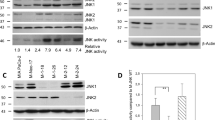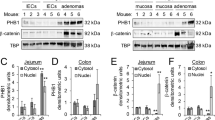Abstract
The proto-oncoprotein c-Jun is a component of the AP-1 transcription factor, the activity of which is augmented in many tumour types1. An important mechanism in the stimulation of AP-1 function is amino-terminal phosphorylation of c-Jun by the c-Jun N-terminal kinases (JNKs)2. Phosphorylated c-Jun is biologically more active, partially because it acquires the ability to interact with binding partners. Here we show that phosphorylated c-Jun interacts with the HMG-box transcription factor TCF4 to form a ternary complex containing c-Jun, TCF4 and β-catenin. Chromatin immunoprecipitation assays revealed JNK-dependent c-Jun–TCF4 interaction on the c-jun promoter, and c-Jun and TCF4 cooperatively activated the c-jun promoter in reporter assays in a β-catenin-dependent manner. In the ApcMin mouse model of intestinal cancer6, genetic abrogation of c-Jun N-terminal phosphorylation3 or gut-specific conditional c-jun inactivation4,5 reduced tumour number and size and prolonged lifespan. Therefore, the phosphorylation-dependent interaction between c-Jun and TCF4 regulates intestinal tumorigenesis by integrating JNK and APC/β-catenin, two distinct pathways activated by WNT signalling.
This is a preview of subscription content, access via your institution
Access options
Subscribe to this journal
Receive 51 print issues and online access
$199.00 per year
only $3.90 per issue
Buy this article
- Purchase on Springer Link
- Instant access to full article PDF
Prices may be subject to local taxes which are calculated during checkout




Similar content being viewed by others
References
Eferl, R. & Wagner, E. F. AP-1: a double-edged sword in tumorigenesis. Nature Rev. Cancer 3, 859–868 (2003)
Davis, R. J. Signal transduction by the JNK group of MAP kinases. Cell 103, 239–252 (2000)
Behrens, A., Sibilia, M. & Wagner, E. F. Amino-terminal phosphorylation of c-Jun regulates stress-induced apoptosis and cellular proliferation. Nature Genet. 21, 326–329 (1999)
Behrens, A. et al. Impaired postnatal hepatocyte proliferation and liver regeneration in mice lacking c-jun in the liver. EMBO J. 21, 1782–1790 (2002)
el Marjou, F. et al. Tissue-specific and inducible Cre-mediated recombination in the gut epithelium. Genesis 39, 186–193 (2004)
Moser, A. R. et al. ApcMin, a mutation in the murine Apc gene, predisposes to mammary carcinomas and focal alveolar hyperplasias. Proc. Natl Acad. Sci. USA 90, 8977–8981 (1993)
Giles, R. H., van Es, J. H. & Clevers, H. Caught up in a Wnt storm: Wnt signalling in cancer. Biochim. Biophys. Acta 1653, 1–24 (2003)
Fodde, R. The APC gene in colorectal cancer. Eur. J. Cancer 38, 867–871 (2002)
Veeman, M. T., Axelrod, J. D. & Moon, R. T. A second canon. Functions and mechanisms of β-catenin-independent Wnt signalling. Dev. Cell 5, 367–377 (2003)
Angel, P., Hattori, K., Smeal, T. & Karin, M. The jun proto-oncogene is positively autoregulated by its product, Jun/AP1. Cell 55, 875–885 (1988)
Behrens, A., Jochum, W., Sibilia, M. & Wagner, E. F. Oncogenic transformation by ras and fos is mediated by c-Jun N-terminal phosphorylation. Oncogene 19, 2657–2663 (2000)
Nateri, A. S., Riera-Sans, L., Da Costa, C. & Behrens, A. The ubiquitin ligase SCFFbw7 antagonizes apoptotic JNK signalling. Science 303, 1374–1378 (2004)
Stein, B. et al. Ultraviolet-radiation induced c-jun gene transcription: two AP-1 like binding sites mediate the response. Photochem. Photobiol. 55, 409–415 (1992)
Staal, F. J. et al. Wnt target genes identified by DNA microarrays in immature CD34 + thymocytes regulate proliferation and cell adhesion. J. Immunol. 172, 1099–1108 (2004)
Mann, B. et al. Target genes of β-catenin-T cell-factor/lymphoid-enhancer-factor signalling in human colorectal carcinomas. Proc. Natl Acad. Sci. USA 96, 1603–1608 (1999)
He, T. C. et al. Identification of c-MYC as a target of the APC pathway. Science 281, 1509–1512 (1998)
Wada, T. et al. MKK7 couples stress signalling to G2/M cell-cycle progression and cellular senescence. Nature Cell Biol. 6, 215–226 (2004)
Tetsu, O. & McCormick, F. β-catenin regulates expression of cyclin D1 in colon carcinoma cells. Nature 398, 422–426 (1999)
Raivich, G. et al. The AP-1 transcription factor c-Jun is required for efficient axonal regeneration. Neuron 43, 57–67 (2004)
Wielenga, V. J. et al. Expression of CD44 in Apc and Tcf mutant mice implies regulation by the WNT pathway. Am. J. Pathol. 154, 515–523 (1999)
Sansom, O. J. et al. Loss of Apc in vivo immediately perturbs Wnt signalling, differentiation, and migration. Genes Dev. 18, 1385–1390 (2004)
Bogoyevitch, M. A., Boehm, I., Oakley, A., Ketterman, A. J. & Barr, R. K. Targeting the JNK MAPK cascade for inhibition: basic science and therapeutic potential. Biochim. Biophys. Acta 1697, 89–101 (2004)
Borsello, T. et al. A peptide inhibitor of c-Jun N-terminal kinase protects against excitotoxicity and cerebral ischemia. Nature Med 9, 1180–1186 (2003)
Alberts, A. S., Geneste, O. & Treisman, R. Activation of SRF-regulated chromosomal templates by Rho-family GTPases requires a signal that also induces H4 hyperacetylation. Cell 92, 475–487 (1998)
Acknowledgements
We would like to thank T. Akiyama, K. Niemann, G. Peters and F. Watt for providing essential reagents. We are grateful to A. Gilkar, W. Jochum, E. Nye and G. Stamp for technical help and advice on histology. We thank K. Sabapathy, I. Tomlinson and R. Treisman for critical reading of the manuscript. The London Research Institute is funded by CR UK.
Author information
Authors and Affiliations
Corresponding author
Ethics declarations
Competing interests
A.S.N. and A.B. are named as inventors on a patent application proposing inhibition of the c-Jun–TCF4 interaction as a therapeutic strategy for intestinal neoplastic disease.
Supplementary information
Supplementary Figures S1-S7
This file contains seven Supplementary Figures. Supplementary Figure S1: Determination of the c-Jun phosphorylation sites required for TCF4 binding. Supplementary Figure S2: Comparable expression of c-Jun and c-Jun4A in HCT 116 cells. Supplementary Figure S3: Nuclear β-catenin protein levels in several cell lines. Supplementary Figure S4: Luciferase assays showing cooperative activation of the c-jun promoter by c-Jun/TCF4 in HCT 116 colon cancer cells, but not NIH3T3 fibroblasts. Supplementary Figure S5: Luciferase assays showing cooperative activation of the c-jun promoter by c-Jun/TCF4 in SW480 colon cancer cells. Supplementary Figure S6: Quantification of tumor number in ApcMin/+;c-jun+/+, ApcMin/+; junAA/+ and ApcMin/+; junAA/AA mice. Supplementary Figure S7: Decreased BrdU incorporation in ApcMin/+; junAA/AA adenomas. The file also includes legends to accompany the above Supplementary Figures. (PDF 636 kb)
Supplementary Methods
Additional information on methods used in this study. (PDF 61 kb)
Rights and permissions
About this article
Cite this article
Nateri, A., Spencer-Dene, B. & Behrens, A. Interaction of phosphorylated c-Jun with TCF4 regulates intestinal cancer development. Nature 437, 281–285 (2005). https://doi.org/10.1038/nature03914
Received:
Accepted:
Published:
Issue Date:
DOI: https://doi.org/10.1038/nature03914
This article is cited by
-
c-Jun as a one-way valve at the naive to primed interface
Cell & Bioscience (2023)
-
Identifying novel interactions of the colon-cancer related APC protein with Wnt-pathway nuclear transcription factors
Cancer Cell International (2022)
-
An intrinsic temporal order of c-JUN N-terminal phosphorylation regulates its activity by orchestrating co-factor recruitment
Nature Communications (2022)
-
Temporal dynamics from phosphoproteomics using endoscopic biopsy specimens provides new therapeutic targets in stage IV gastric cancer
Scientific Reports (2022)
-
Anti-miR-135/SPOCK1 axis antagonizes the influence of metabolism on drug response in intestinal/colon tumour organoids
Oncogenesis (2022)
Comments
By submitting a comment you agree to abide by our Terms and Community Guidelines. If you find something abusive or that does not comply with our terms or guidelines please flag it as inappropriate.



